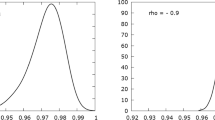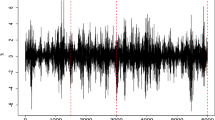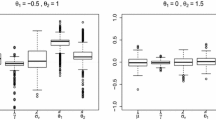Abstract
A threshold stochastic volatility (SV) model is used for capturing time-varying volatilities and nonlinearity. Two adaptive Markov chain Monte Carlo (MCMC) methods of model selection are designed for the selection of threshold variables for this family of SV models. The first method is the direct estimation which approximates the model posterior probabilities of competing models. Using parallel MCMC sampling to estimate these probabilities, the best threshold variable is selected with the highest posterior model probability. The second method is to use the deviance information criterion to compare among these competing models and select the best one. Simulation results lead us to conclude that for large samples the posterior model probability approximation method can give an accurate approximation of the posterior probability in Bayesian model selection. The method delivers a powerful and sharp model selection tool. An empirical study of five Asian stock markets provides strong support for the threshold variable which is formulated as a weighted average of important variables.






Similar content being viewed by others
References
Asai M, McAleer M (2005) Dynamic asymmetric leverage in stochastic volatility models. Econom Rev 24:317–332
Berg A, Meyer R, Yu J (2004) Deviance information criterion for comparing stochastic volatility models. J Bus Econ Stat 22:107–120
Chen R (1995) Threshold variable selection in open-loop threshold autoregressive models. J Time Ser Anal 16:461–481
Chen CWS, So MKP (2006) On a threshold heteroscedastic model. Int J Forecast 22:73–89
Chen CWS, Gerlach RH, So MKP (2006) Comparison of nonnested asymmetric heteroscedastic models. Comput Stat Data Anal (Special issue on Nonlinear Modelling and Financial Econometrics) 51:2164–2178
Chen CWS, Gerlach R, So MKP (2008a) Bayesian model selection for heteroskedastic models. Adv Econ (Special Issue Bayesian Econom) 23:567–594
Chen CWS, Liu FC, So MKP (2008b) Heavy-tailed distributed threshold stochastic volatility models in financial time series. Aust NZ J Stat 50:29–51
Chen CWS, Gerlach R, Lin AMH (2010) Falling and explosive, dormant, and rising markets via multiple-regime financial time series models. Appl Stochast Models Bus Ind 26:28–49
Chen CWS, Gerlach R, Lin EMH, Lee WCW (2012) Bayesian forecasting for financial risk management, pre and post the global financial crisis. J Forecast. doi:10.1002/for.1237
Chib S (1995) Marginal likelihood from the Gibbs output. J Am Stat Assoc 90:1313–1321
Chib S, Jeliazkov I (2001) Marginal likelihood from the Metropolis–Hastings output. J Am Stat Assoc 96:270–281
Congdon P (2006) Bayesian model choice based on Monte Carlo estimates of posterior model probabilities. Comput Stat Data Anal 50:346–357
Congdon P (2007) Model weights for model choice and averaging. Stat Methodol 4:143–157
Franses PH, van Dijk D (2000) Nonlinear time series models in empirical finance. Cambridge University Press, Cambridge
Hamilton JD, Susmel R (1994) Autoregressive conditional heteroskedasticity and changes in regime. J Econom 64:307–333
Harvey AC, Shephard N (1996) Estimation of an asymmetric stochastic volatility model for asset returns. J Bus Econ Stat 14:429–434
Ip WC, Wong H, Li Y, Xie Z (1999) Threshold variable selection by wavelets in open-loop threshold autoregressive models. Stat Probab Lett 42:375–392
Jacquier E, Polson NG, Rossi PE (1994) Bayesian analysis of stochastic volatility models. J Bus Econ Stat 12:69–87
Jacquier E, Polson NG, Rossi PE (2004) Bayesian analysis of stochastic volatility models with fat-tails and correlated errors. J Econom 122:185–212
Kim S, Shephard N, Chib S (1998) Stochastic volatility: likelihood inference and comparison with ARCH models. Rev Econ Stud 65:361–393
Omori Y, Watanabe T (2008) Block sampler and posterior mode estimation for asymmetric stochastic volatility models. Comput Stat Data Anal 52:2892–2910
Robert C, Marin JM (2008) On some difficulties with a posterior probability approximation technique. Bayesian Anal J 2:427–448. doi:10.1214/08-BA316
Scott S (2002) Bayesian methods for hidden Markov models: recursive computing in the 21st century. J Am Stat Assoc 97:337–351
Shephard N (1993) Fitting nonlinear time-series models with applications to stochastic variance models. J Appl Econom 8:135–152
So MKP, Lam K, Li WK (1998) A stochastic volatility model with Markov switching. J Bus Econ Stat 16:244–253
So MKP, Li WK, Lam K (2002) A threshold stochastic volatility model. J Forecast 21:473–500
Spiegelhalter DJ, Best NG, Carlin BP, van der Linde A (2002) Bayesian measures of model complexity and fit. J R Stat Soc Ser B 64:583–639
Taylor SJ (1982) Financial returns modelled by the product of two stochastic processes, a study of daily sugar prices 1961–1979. In: Anderson OD (ed) Time series analysis: theory and practice 1. North-Holland, Amsterdam, pp 203–226
Tong H (1978) On a threshold model. In: Chen CH (ed) Pattern recognition and signal processing. Sijthoff & Noordhoff, Amsterdam
Tong H (1990) Non-linear time series. A dynamical system approach. Clarendon Press, Oxford
Tong H, Lim KS (1980) Threshold autoregression, limit cycles and cyclical data (with discussion). J R Stat Soc Ser B 42:245–292
Wu S, Chen R (2007) Threshold variable determination and threshold variable driven switching autoregressive models. Statistica Sinica 17:241–264
Xia Y, Li WK, Tong H (2007) Threshold variable selection using nonparametric methods. Statistica Sinica 17:265–287
Acknowledgments
We thank the editor and two anonymous referees for their insightful and helpful comments, which improved this paper. Cathy Chen is supported by the grants (NSC 99-2118-M-035-001-MY2 and NSC 101-2118-M-035-006-MY2) from the National Science Council (NSC) of Taiwan.
Author information
Authors and Affiliations
Corresponding author
Appendix
Appendix
By Bayesian inference, the posterior conditional distributions of all parameters can be conducted as follows:
-
1.
\({\varvec{\phi }} \mid {\varvec{\theta }}_{-{\varvec{\phi }}}, {\varvec{R}}, {\varvec{X}}_1, {\varvec{H}}_n, {\varvec{\lambda }}_n \sim {\varvec{N}} \left( {\varvec{\mu }}_{{\varvec{\phi }}}, {\varvec{\Sigma }}_{{\varvec{\phi }}} \right) \), where \({\varvec{\Sigma }}_{{\varvec{\phi }}} = ({\varvec{Y}}_1^{\prime } {\varvec{Y}}_1 +{\varvec{\Lambda }}_1^{-1})^{-1}\) and \({\varvec{\mu }}_{{\varvec{\phi }}} = {\varvec{\Sigma }}_{{\varvec{\phi }}} ({\varvec{Y}}_1^{\prime } {\varvec{K}}_1 + {\varvec{\Lambda }}_1^{-1} {\varvec{\mu }}_1)\). The hyper-parameters \({\varvec{\mu }}_1\) and \({\varvec{\Lambda }}_1\) are the mean and variance of prior distribution of \({\varvec{\phi }}\). The matrices \({\varvec{K}}_1\) and \({\varvec{Y}}_1\) are
$$\begin{aligned} {\varvec{K}}_1 \!=\! \left[ \begin{array}{c} c_{d+1}R_{d+1} \\ \vdots \\ c_{t}R_{t} \\ \vdots \\ c_{n}R_n \end{array} \right] \, \text{ and } \, {\varvec{Y}}_1 \!=\! \left[ \begin{array}{ccccccc} c_{d+1} &{} c_{d+1} s_{d+1} &{} c_{d+1} R_d &{} c_{d+1} s_{d+1} R_d &{} c_{d+1} x_d &{} c_{d+1} s_{d+1} x_d \\ \vdots &{} \vdots &{} \vdots &{} \vdots &{} \vdots &{} \vdots \\ c_t &{} c_t s_t &{} c_t R_{t-1} &{} c_t s_t R_{t-1} &{} c_t x_{t-1} &{} c_t s_t x_{t-1} \\ \vdots &{} \vdots &{} \vdots &{} \vdots &{} \vdots &{} \vdots \\ c_n &{} c_n s_n &{} c_n R_{n-1} &{} c_n s_n R_{n-1} &{} c_n x_{n-1} &{} c_n s_n x_{n-1} \\ \end{array} \right] , \end{aligned}$$where \(c_t=\sqrt{\frac{\nu }{(\nu -2)} \frac{\lambda _{t}}{\sigma ^2_{t}}}\).
-
2.
\({\varvec{\alpha }} \mid {\varvec{\theta }}_{-{\varvec{\alpha }}}, {\varvec{R}}, {\varvec{X}}_1, {\varvec{H}}_n, {\varvec{\lambda }}_n \sim {\varvec{N}} \left( {\varvec{\mu }}_{{\varvec{\alpha }}}, {\varvec{\Sigma }}_{{\varvec{\alpha }}} \right) I_{(|\alpha _1|<1)} I_{(|\alpha _1+\beta _1|<1)}\), where \({\varvec{\Sigma }}_{{\varvec{\alpha }}} = ({\varvec{Y}}_2^{\prime } {\varvec{Y}}_2 + {\varvec{\Lambda }}_2^{-1})^{-1}\) and \({\varvec{\mu }}_{{\varvec{\alpha }}} = {\varvec{\Sigma }}_{{\varvec{\alpha }}} ({\varvec{Y}}_2^{\prime } {\varvec{K}}_2 + {\varvec{\Lambda }}_2^{-1} {\varvec{\mu }}_2)\). The hyper-parameters \({\varvec{\mu }}_2\) and \({\varvec{\Lambda }}_2\) are the mean and variance of prior distribution of \({\varvec{\alpha }}\). The matrices \({\varvec{K}}_2\) and \({\varvec{Y}}_2\) are
$$\begin{aligned} {\varvec{K}}_2 = \left[ \begin{array}{c} h_{d+1} \\ \vdots \\ h_n \end{array} \right] \quad \text{ and } \quad {\varvec{Y}}_2 = \frac{1}{\sqrt{\sigma ^2}} \left[ \begin{array}{cccc} 1 &{} s_{d+1} &{} h_d &{} s_{d+1}h_d \\ \vdots &{} \vdots &{} \vdots &{} \vdots \\ 1 &{} s_n &{} h_{n-1} &{} s_n h_{n-1} \end{array} \right] . \nonumber \end{aligned}$$ -
3.
\(f\left( r \mid {\varvec{\theta }}_{-r}, {\varvec{R}}, {\varvec{X}}_1, {\varvec{H}}_n, {\varvec{\lambda }}_n \right) \propto L\left( {\varvec{R}} \mid {\varvec{X}}_1, {\varvec{\theta }}, {\varvec{H}}_n, {\varvec{\lambda }}_n \right) I_{(l \le r \le u)}\).
-
4.
\(Pr\left( d=j| {\varvec{\theta }}_{-d}, {\varvec{R}}, {\varvec{X}}_1, {\varvec{H}}_n, {\varvec{\lambda }}_n \right) = \frac{ L\left( {\varvec{R}}| {\varvec{X}}_1, {\varvec{H}}_n, {\varvec{\lambda }}_n, {\varvec{\theta }}_{-d}, d=j \right) \pi (d=j)}{\sum _{k=1}^{d_0} L\left( {\varvec{R}}| {\varvec{X}}_1, {\varvec{H}}_n, {\varvec{\lambda }}_n, {\varvec{\theta }}_{-d}, d=k \right) \pi (d=k)}\).
-
5.
\(f\left( \nu \mid {\varvec{\theta }}_{-\nu }, {\varvec{R}}, {\varvec{X}}_1, {\varvec{H}}_n \right) \propto \prod _{t = d_0 + 1}^n \frac{\Gamma (\frac{\nu +1}{2})}{\Gamma (\frac{\nu }{2})\sqrt{(\nu -2)\pi }}\frac{1}{\sqrt{\sigma ^2_t}} \left( 1+\frac{a_{t}^{2}}{(\nu -2) \sigma ^2_t } \right) ^{- \frac{\nu + 1}{2}} \pi (\nu )\).
-
6.
\(\lambda _t \mid {\varvec{\theta }}, {\varvec{R}}, {\varvec{X}}_1, {\varvec{H}}_n \sim Gamma\left( \frac{\nu +1}{2},\frac{\nu }{2}+\frac{\nu a_t^{2}}{2(\nu -2)\sigma ^2_t} \right) \).
-
7.
\(f\left( \omega _1 | {\varvec{\theta }}_{-{\varvec{\omega }}}, {\varvec{R}}, {\varvec{X}}_1, {\varvec{H}}_n, {\varvec{\lambda }}_n \right) \propto L({\varvec{R}} | {\varvec{X}}_1, {\varvec{H}}_n, {\varvec{\lambda }}_n, {\varvec{\theta }}) \pi (\omega _1)\).
-
8.
\(f\left( \sigma ^2 \mid {\varvec{\theta }}_{-\sigma ^2}, {\varvec{R}}, {\varvec{X}}_1 \right) \propto f\left( {\varvec{R}} \mid {\varvec{X}}_1, {\varvec{\theta }} \right) I_{(0 \le \sigma ^2 \le b)}\).
-
9.
\( h_t \mid h_{t+1}, {\varvec{\theta }}, {\varvec{\rho }}_n, {\varvec{R}}, {\varvec{X}}_1, {\varvec{\lambda }}_n \sim N\left( \mu ^*, \Sigma ^* \right) \), where \(\mu ^*\) and \(\Sigma ^*\) are computed by Kalman filtering algorithm. It is based on a approximated Gaussian state space model, the approximation of Gaussian distribution is suggested by Kim et al. (1998) with introducing a vector of mixing indicator \({\varvec{\rho }}_n\) for the mixture of normals. For more details, refer to Chen et al. (2008b).
Rights and permissions
About this article
Cite this article
Chen, C.W.S., Liu, FC. & So, M.K.P. Threshold variable selection of asymmetric stochastic volatility models. Comput Stat 28, 2415–2447 (2013). https://doi.org/10.1007/s00180-013-0412-y
Received:
Accepted:
Published:
Issue Date:
DOI: https://doi.org/10.1007/s00180-013-0412-y




